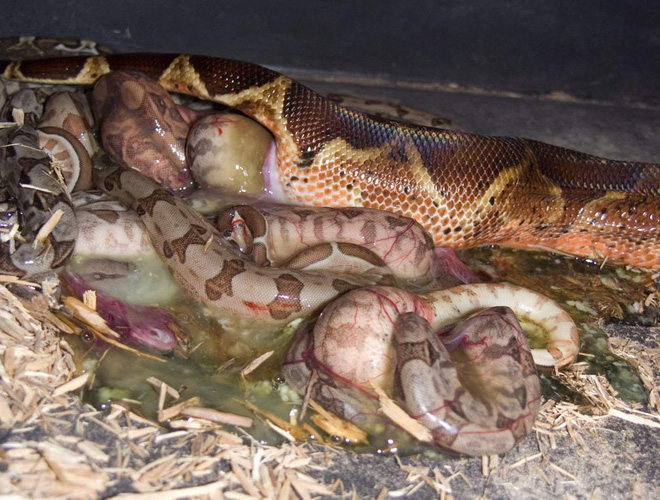South American monsters - Spawn anaconda or spawn?
According to research by scientists 70% of the world's snakes are laying eggs and 30% of the remaining species will give birth. But the giant Anaconda python spawn or give birth, do you know?
- Shivered, grappling with the giant South American python underwater
- Scary nape with the largest mouse hunting screen in the world of the "beast" giant Anaconda
- How big is the biggest snake ever recorded?

Based on the differences in childbirth, experts divided the snake family into 3 groups:
- Oviparous group: spawn, often living in hot climates.
- Group Viviparous: giving birth, usually living in colder areas because the ground is not warm enough to hatch eggs.
- Ovoviviparous group: oviparous, meaning that the embryo develops in the egg but when the mother is born, the egg is removed. Their habitat is like a group of babies.
With giant Anaconda pythons that are up to 9 m long and weigh 250 kg, they give birth and every time the python gives birth, there will be about 40 Anaconda babies born.

This animal's egg will be fertilized right in the womb and develop into a fetus in the womb and be fed through the placenta.
When Anaconda's mother becomes pregnant, her child will come out through the anal. The ovule (usually orange) will break, and the baby Anaconda will officially "celebrate life".
In the process of extremely strenuous reproduction, Anaconda's mother sometimes ate the baby's ovum or the dead baby to gain more energy.
Immediately after birth, the offspring will begin to look for their first meal in their lives. In order to survive in the wild natural world full of danger, they must spread themselves. If they are lucky, they will get plankton and start their lives, whereas if they unfortunately face Piranhas, their life will be short.
You should read it
- Scary nape with the largest mouse hunting screen in the world of the giant 'beast' Anaconda
- How to Set Up a Python Environment for Deep Learning
- Shivered, grappling with the giant South American python underwater
- How big was the biggest snake ever recorded?
- The advantages and risks you may face of having children in your 20s and 30s
- Looking for 'super athletes' in the animal world?
 The mystery of the giant tape disk spinning between the river was finally deciphered
The mystery of the giant tape disk spinning between the river was finally deciphered Most modern horse breeds can originate from the East
Most modern horse breeds can originate from the East Mysterious sea creatures do not have eyes, mouth washes on American beaches
Mysterious sea creatures do not have eyes, mouth washes on American beaches Plants use Hydrogen Peroxide as sunscreen
Plants use Hydrogen Peroxide as sunscreen The most bizarre creatures are found by scientists under the sea floor of Australia
The most bizarre creatures are found by scientists under the sea floor of Australia Do not confuse the vegetables as weeds, you will be shocked to know its miraculous use!
Do not confuse the vegetables as weeds, you will be shocked to know its miraculous use!